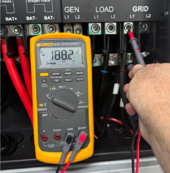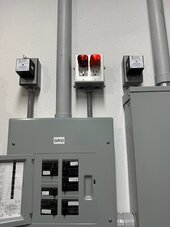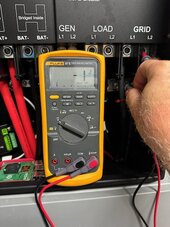OK, so I connected a neon outlet tester to L1 (two neon bulbs plus current limiting resistors in parallel), and the voltage dropped to 90V (as expected), though it did light up the lights. Grid on the Left, glowing but not very brightly:
View attachment 225171
Then I plugged a 60W incandescent bulb into L2 and the Neon bulbs went out, and the voltage dropped to 25V on L1 (the neon tester), and 1V on L2 (the 60W bulb).
View attachment 225172View attachment 225173View attachment 225174
So I'm going to say that with an appropriate selection of incandescent "Pilot Lights" you can drive the DC "grid sensing voltage" as low as you want to make your Utility/AHJ/Electricians happy. I don't have my resistance substitution box or a selection of incandescent bulbs, but I can't imagine you need much load if a neon bulb can draw the voltage down to its breakdown voltage.
So there's nothing "wrong" with your inverter, all 18Kpv do that, and while the voltage is high, the impedance is really high too, and the hazard is nonexistent. No need for an RMA.
@SignatureSolarJess
Signature Solar, your Utility, and your two Master Electricians should know this stuff or be able to figure it out without your having to spend 5 weeks and an RMA on it. I mean, it's their fracking job to know the difference between volts, amps, power, etc. Put a DVM on _any_ disconnected wire and measure the AC and DC potential.
Also, not to put too fine a point on it, but SS should be able to sort this out with one phone call to the EG4/LuxPower engineering team: "Hey, there's 190V (that Half Bus Voltage, Modbus VbusP?) DC on the Grid terminals to ground when there's no grid, what's with that?". "Oh, yeah, that's the grid detection circuit, very high impedance, if it bothers anyone put a 1W incandescent pilot light on each of L1 and L2."
/GrumpyOldMan







